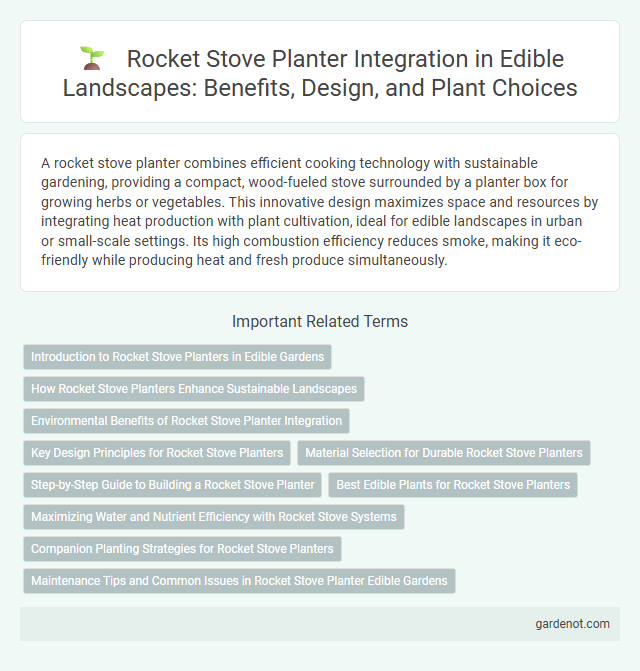A rocket stove planter combines efficient cooking technology with sustainable gardening, providing a compact, wood-fueled stove surrounded by a planter box for growing herbs or vegetables. This innovative design maximizes space and resources by integrating heat production with plant cultivation, ideal for edible landscapes in urban or small-scale settings. Its high combustion efficiency reduces smoke, making it eco-friendly while producing heat and fresh produce simultaneously.
Introduction to Rocket Stove Planters in Edible Gardens
Rocket stove planters combine efficient cooking technology with edible gardening by integrating a high-efficiency combustion chamber into a planter structure. This innovative design provides heat for cooking or warmth while simultaneously supporting the growth of vegetables, herbs, or fruits. By recycling biomass fuel for cooking, rocket stove planters enhance sustainability and maximize space in urban or small-scale edible landscapes.
How Rocket Stove Planters Enhance Sustainable Landscapes
Rocket stove planters enhance sustainable landscapes by combining efficient biomass combustion with productive gardening spaces, reducing waste and carbon emissions. Their insulated combustion chambers maximize fuel efficiency, lowering the need for external energy sources while producing nutrient-rich ash for soil enrichment. Integrating cooking and planting functions promotes resource conservation and supports resilient, eco-friendly urban agriculture systems.
Environmental Benefits of Rocket Stove Planter Integration
Integrating a rocket stove planter reduces reliance on fossil fuels by utilizing efficient biomass combustion, significantly lowering carbon emissions. This sustainable system repurposes organic waste as fuel, minimizing landfill contributions and enhancing soil fertility through biochar residue. Its low-smoke design improves air quality, contributing positively to local ecosystems and promoting eco-friendly urban agriculture.
Key Design Principles for Rocket Stove Planters
Rocket stove planters integrate efficient combustion technology with sustainable gardening by prioritizing insulation, airflow, and fuel efficiency. Key design principles include using high-temperature resistant materials to contain heat, creating an optimized airflow path that maximizes fuel combustion and minimizes smoke, and incorporating a planter section that captures heat to promote plant growth. Ensuring proper balance between thermal mass and ventilation enhances both cooking performance and soil temperature regulation for edible landscapes.
Material Selection for Durable Rocket Stove Planters
Selecting high-quality refractory bricks and heat-resistant steel ensures the durable construction of rocket stove planters, capable of withstanding intense heat cycles without cracking. Incorporating fireproof insulation materials such as ceramic fiber or vermiculite enhances thermal retention and safety for edible landscape applications. Proper material choice extends the lifespan of rocket stove planters while maintaining safe and efficient cooking conditions within integrated garden designs.
Step-by-Step Guide to Building a Rocket Stove Planter
Building a rocket stove planter involves assembling high-heat resistant bricks to form a combustion chamber and insulated burn tunnel, maximizing efficient fuel combustion for cooking or heating. Incorporate soil-filled planter boxes around the stove's chimney, using nutrient-rich compost to support edible plants like herbs or vegetables. Ensure proper ventilation and insulation with materials such as perlite or vermiculite to maintain airflow and retain heat while fostering a sustainable edible garden ecosystem.
Best Edible Plants for Rocket Stove Planters
Rocket stove planters thrive with nutrient-rich, fast-growing edible plants such as kale, Swiss chard, and lettuce, which adapt well to the warm microclimate created by the stove's heat. Herbs like basil, thyme, and rosemary also benefit from the consistent warmth, enhancing growth and flavor intensity. Compact root vegetables like radishes and baby carrots are ideal for these planters due to their shallow root systems and quick maturity.
Maximizing Water and Nutrient Efficiency with Rocket Stove Systems
Rocket stove planters enhance water and nutrient efficiency by integrating insulated combustion chambers that generate biochar, enriching soil fertility and moisture retention. This system optimizes heat distribution, promoting faster composting and nutrient cycling within the planter's ecosystem. Efficient thermal management reduces water evaporation, ensuring sustained hydration for edible plants in permaculture gardens.
Companion Planting Strategies for Rocket Stove Planters
Rocket stove planters thrive when integrating companion planting strategies that maximize space and nutrient use, such as pairing nitrogen-fixing legumes with heavy-feeding vegetables like tomatoes. Strategic plant combinations like basil or marigold not only deter pests but enhance the growth environment around the rocket stove's heat-efficient structure. Optimizing companion plants within a rocket stove planter boosts yields, promotes soil health, and supports sustainable, energy-saving edible landscapes.
Maintenance Tips and Common Issues in Rocket Stove Planter Edible Gardens
Regular maintenance of a rocket stove planter in edible gardens involves clearing ash buildup and monitoring for cracks in the clay or metal components to ensure efficient combustion and heat retention. Common issues include soot accumulation that can affect plant health and potential moisture damage, which requires sealing and protective coatings to prolong the planter's lifespan. Frequent inspection of airflow channels and timely removal of debris help maintain optimum stove function while supporting healthy edible plant growth.
Rocket stove planter Infographic

 gardenot.com
gardenot.com